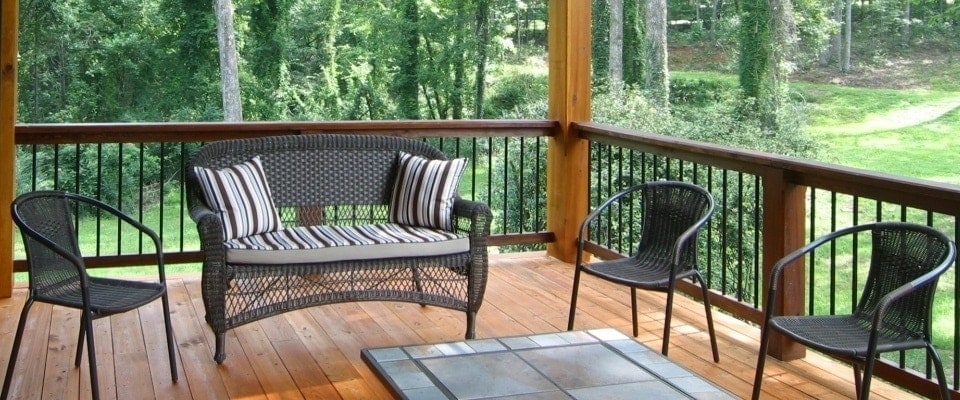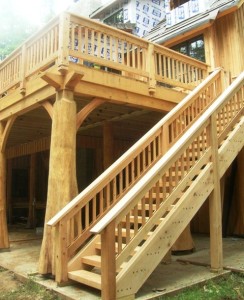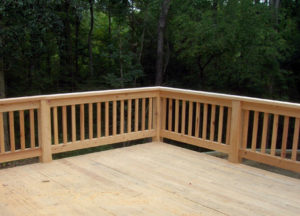The snow has melted and spring flowers are peeking through the cold, damp soil. You’ve started trimming winter-damaged plants and are removing the windblown leaves and debris that’s accumulated on your yard and in your planting beds. This warmer weather has you dreaming of long, languorous Sunday afternoons that fade into evening relaxing in a comfortable lounge chair in the fresh air. Design a deck for your timber frame home to fully enjoy your outdoor space.

Design A Deck That Complements Your Home
Your deck should round out your home and yard. Consider where it will sit along the exterior of the house, and how it fits with the windows and doors along that plane. It should harmonize with the design of your home’s exterior, and act as a foil for moving from inside the house to the outside yard.
The size of an average deck is roughly 12 to 18 percent of the total square footage of a house. Regard it as another room that requires the same design tenets and considerations. Windows and doors of your home should be weighed as you plan your deck. Position the area so that it harmonizes with the existing openings and architectural elements of the exterior facade.
Plan Your Deck To Function With Your Family’s Needs
If you plan to use your deck for dining and entertaining, it makes sense to position it adjacent to your kitchen. Outdoor grilling and meals for family and friends is one of the main uses of a deck, so ease of food preparation, staging and serving is high on the list of necessities. A kitchen entrance that leads directly to the deck is common and a good way to make life simple for the host and hostess.

If your deck will be the scene of dinner parties and social occasions, plan adequate space for a dining area with a table and chairs. A screened gazebo or sheltered pergola is a perfect setting for an outdoor dining room.
Outdoor kitchens and fireplaces are growing in popularity. If that’s not in the cards right now, are these things you may want in the future? If you might consider them at a later date, do a little research now on how they may fit with your existing deck or how your deck could be expanded to incorporate them later.
If a hot tub is part of your design, consider its location on the deck. Consider how to address any privacy issues or how bathers can access other rooms in your home.
Plan A Layout And Size That’s Right For You
When you’re planning your deck, there are limitless sizes and shapes. Don’t be locked into a staid rectangle if your property screams for a different shape. You can alter the shape, size and level of your deck to give it personality and add to its function. You and your family are the ones who’ll be using it, so plan it to fit in with your lifestyle.
Maybe you want to separate zones visually and physically. You may connect decking areas that lie at different levels to separate dining, entertaining and spa areas. A bump-out area at one end of the deck may accommodate the hot tub, or a hexagon area adjacent to the grilling area may contain the dining table and chairs.
Whatever your design ideas, you should plot out your area with a garden hose or a can of spray paint to indicate the perimeter of your space. It’s a good idea to use two-foot increments when planning your deck, as lumber is generally available in 8 to 16 foot lengths. If you stick with standard materials, you’ll reduce waste and save time cutting odd lengths of wood.
The width of a deck is no problem. You just keep adding joists, and your deck can just keep getting wider and wider. However, you do have to consider how deep your deck will be. Common 2 x 8 inch joists can span no more than 12 feet without a set of posts and beams. Consider the amount of labor as well as materials when you’re designing your deck.
Stairs, Railings And Other Considerations

The rise and run of your steps are generally set between 10 and 12 inches. This standard is for safety, more so than aesthetics. If your deck is a second floor structure, a landing on the way down to the ground level is another safety feature you should consider.
Railings are generally required for any deck that is more than 30 inches above ground and for stairs that have more than four steps. Your local building code will specify the required height, but it typically ranges from 36 to 42 inches. Spacing between the vertical posts should be from four to six inches, and the height between the deck and the bottom of the rail is about two to four inches.
Another area you should investigate is how things like your water spigots and dryer vent may impact your deck design. If you position your deck below these features, you’ll have easy accessibility. No need to go crawling under the deck for maintenance or to attach or remove hoses. Check the location of your downspouts to ensure your deck location doesn’t cause problems there, too.
Planning your deck is very similar to designing an addition to your home. You should consider how it blends in with your existing structure, how it impacts your yard and how you can best utilize the area to make it a welcome addition to your timber frame home living space.
I hadn’t thought about connecting the deck with different areas for dining or a hot tub. My wife and I want to update our deck soon and we want to have enough space to put a hot tub on it. We’ll be sure to find the right contractor and use the correct materials so it lasts a long time.